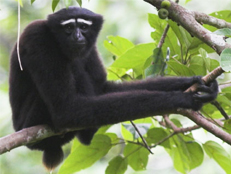 info@kaziranga-national-park.com
info@kaziranga-national-park.com + 9212777225 / 9212553107
+ 9212777225 / 9212553107

- Home/
- Kaziranga Wildlife Special /
- Hoolock Gibbons
Hoolock Gibbons

The hoolock gibbons, also known as hoolocks, one of the most important attractions of north east india’s wildlife, hoolock gibbons are two primate species from the family of the gibbons. Hoolocks are the second largest of the gibbons, after the Siamang. Normally they reach a size of 60 to 90 cm and weigh 6 to 9 kg. Both male and female gibbons are about the same size, but they differ considerably in colors. Males are black colored with remarkable white brows, while females have a grey-brown fur, which is darker at the chest and neck. White rings around the eyes and around the mouth give their face a mask-like appearance.
The range of the hoolocks is the most northwestern of all the gibbons, extending from Assam in North-East India, to Myanmar. Small populations (in each case few hundred animals) live also in the eastern Bangladesh and in southwest China. Like the other gibbons, they are diurnal and arboreal, brachiating through the trees with their long arms. They live together in monogamous pairs, which stake out a territory. Their calls serve to locate family members and ward off other gibbons from their territory. Their diet consists mainly of fruits, insects and leaves.
Young hoolocks are born after a seven month gestation, with a milky white fur. After about six months their fur turns blablack. After 8 to 9 years they are fully mature and their fur reaches its final coloration. Their life expectancy in the wild is about 25 years.
 Share
Share Home
Home Packages
Packages Book Now
Book Now